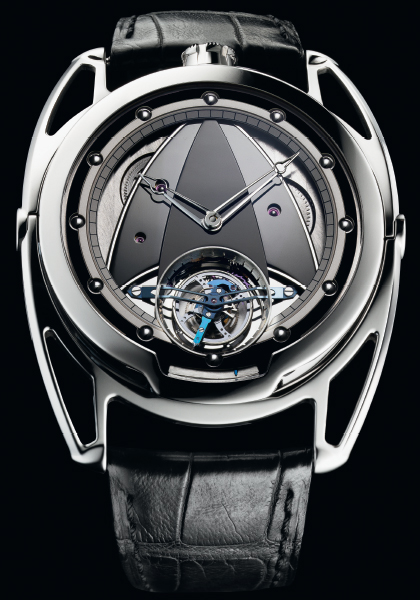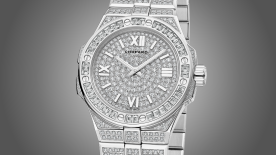De Bethune brought out its first tourbillon in 2009 for the Dream Watch 3. There are two reasons why it has not been chosen here. Firstly, it’s just too improbable. Secondly, although its dial was elaborate, it was also quite standard. That was not the case when, two years later, in 2011, De Bethune reused the DB2019 movement in its more recent creation, the DB28 – a collection that is still current. The DB28T doesn’t have the added, decorated plate commonly referred to as the dial. Instead, it has a kind of steel cover over part of the calibre, revealing the De Bethune ribbed pattern on the baseplate and two barrels. And most importantly, it boasts a level of finishing that has remained unrivalled ever since.
Ultra-glossy
This ‘movement cover’ has three parts, and an arrow shape recalling Star Trek’s Starfleet emblem. The entire surface is specular or black-polished, meaning that depending on the angle, it can appear wholly dark. It represents the ultimate in hand finishes – the kind of discouragingly lengthy work in which any error is fatal. The finish is normally applied to flat surfaces just a few millimetres long, whereas the DB28T movement cover is rounded in both planes and measures several square centimetres. There had quite simply never been anything like it.
Ultra-technical
On either side of the opening dedicated to the tourbillon, mirror-polished bridges have been used to secure the tourbillon bridge; the latter is openworked in two planes and blue-tinted. At De Bethune, bluing is all manually done using a flame on each component, rather than in a kiln. The tourbillon bridge holds in place a tourbillon that, in its day, was the most technically advanced ever designed. It was created primarily to fulfil the dictates of chronometry, rather than to be attractive, bear a brand logo, or create an impression of classical balance; its unusual appearance is due to the brand’s almost mystical quest for performance.

Ultra-fast
The cage bridge has just one arm rather than two or three, making it asymmetrical; this is made from blue-tinted titanium. Just below it sits a flat hairspring featuring a proprietary terminal curve. This saves height compared to high Breguet-type curves, whilst providing the same advantages in terms of concentricity: it oscillates around a constant centre of gravity at all times. The balance is on the next level down, with a platinum rim and silicon spokes delivering the best possible inertia-weight ratio, further improved by the spokes being openworked. At the lowest level comes the escapement, formed by a sideways openwork titanium pallet-lever and a silicon wheel. In 2011, silicon was still a cutting-edge material for this type of work, and hard to come by. It was however very useful when it came to absorbing the friction caused by the 5Hz frequency; the balance oscillates at 36,000 vibrations per hour. The cage completes one rotation every 30 seconds: in 2009, when it made its first appearance in the DW3, this tourbillon was the fastest ever created.
Ultra-light
In yet another superlative to which De Bethune can also lay claim here, the tourbillon is also the lightest. The entire 63-component cage weighs only 0.18g; while tourbillon weights are almost always less than one gramme, they generally weigh in at around 0.5g. The combination of all these figures is positively dizzying: with three times less mass than usual, high-frequency oscillation, and a rotation speed that’s twice as fast as normal, this is a Formula 1 racer among tourbillons. Furthermore, notwithstanding these high speeds (which consume a considerable amount of extra energy) the DB2019 calibre’s twin barrels provide a 120-hour power reserve, indicated on a gauge visible through a small opening on the caseback.
Ultra-comfortable
There’s still one more cherry on this particular cake. The DB28 series inaugurated an extremely practical, pragmatic, comfortable De Bethune concept: a case sporting two generous, openworked floating lugs forming a broad platform on which to carry the round case. The result on the wrist was (and still is) spectacular. The floating arches ensure the watch is a perfect fit for everyone, immediately and automatically adjusting the curve of the case to provide a bespoke match.
*This year GMT Magazine and WorldTempus have embarked on the ambitious project of summarising the last 20 years of the Tourbillon in The Millennium Watch Book - Tourbillons, a big, beautifully laid out coffee table book. This article is an extract. The Millennium Watch Book - Tourbillons is available on www.the-watch-book.com, in French and English.






